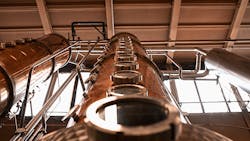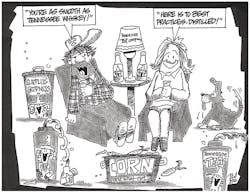Greg: We continue our conversation with Mark Darby to gain insights as to how to achieve the best column control. To add to the discussion, we are bringing in Doug Nicholson, a senior consultant with Spiro Control, who has implemented controls on numerous distillation columns.
Let’s discuss pressure control, which should be properly viewed as another inventory variable.
Mark: Good point. Pressure is affected by changes in accumulation of vapor in the column, which for a liquid distillate (total condenser) can be controlled by changing the condenser or reboiler duty (energy balance), with condenser duty being the most common. With a partial condenser (distillate is partially or totally vapor), the amount of vapor distillate affects pressure though the vapor flow rate (material balance). A similar principle uses non-condensable gas to control pressure using make-up and bleed-off valves.
Doug: For pressure control via condenser duty, it is common to manipulate the cooling medium flow. Another common approach, especially with water- and air-cooled exchangers, is to vary the exchanger area by varying the volume of condensed liquid on the process side of the exchanger, which results in sub-cooled reflux. The hot vapor bypass and flooded reflux drum are examples. Sometimes with refrigerant condensers, a level controller is used to control liquid refrigerant levels in the condenser by manipulating refrigerant flow, with pressure manipulating refrigerant level setpoint. The motivation for this scheme is to limit the maximum refrigerant level setpoint to prevent liquid carryover in the compressor return, but a more direct approach with improved dynamics response is to have the pressure controller directly manipulate the refrigerant flow with an override from maximum refrigerant level.
Greg: The dynamic characteristics are, of course, different for the various pressure control schemes. A material balance scheme is typically fast and may be either self-regulating or integrating. A scheme that changes condenser duty is often near integrating and will have thermal lags. In addition, a hot vapor bypass and flooded reflux drum will have a lag associated with the liquid volume effect (as exchanger tubes are covered/uncovered by condensed liquid), which will allow a high controller gain.
What about disturbances with the various schemes?
Mark: One disturbance to highlight is the impact of ambient changes on air and cooling water exchangers, which can be significant, especially if portions of the column aren't insulated. A column temperature controller will help reduce the impact of these disturbances. It may also be helpful to implement an internal liquid flow controller, in which the internal flow is calculated from the reflux flow with a correction from the difference between the overhead and reflux temperatures. Changes in overhead temperature caused by rising impurities will result in an incorrect response, which must be corrected by feedback from the temperature or composition controller. If this effect is significant, it may be appropriate to suppress the contribution from the overhead temperature (e.g., by filtering or treating it as a constant).
Greg: The distillation control specialists in engineering technology of the company I worked advocated level control of the distillate receiver by manipulating the reflux flow because this provided some degree of internal reflux flow control. A cold rainstorm would decrease overhead vapor flow, which would translate to a decrease in level and consequential decrease in reflux flow that helped to increase vapor flow. This works if the level measurement is sensitive, the level controller gain is maximized for tight level control, and the receiver isn't a horizontal tank. For more on the potential for internal reflux control see the ISA book Advanced Temperature Measurement and Control Second Edition. Non-contacting radar can provide the sensitivity and external reset-feedback can facilitate the use of a large PID gain that is faster than the response of the reflux flow controller.
Is pressure controller always required?
Doug: No, not always. I have seen it’s possible for close-boiling mixtures with a refrigerant condenser with small temperature difference, where pressure floats on this temperature difference (self-regulating). The typical situation is where there is limited condenser capacity due to increased throughput relative to design, and the pressure controller output often saturates, causing the pressure to float. In this situation, you'd keep the pressure controller in auto to protect on the low side. High pressure can only be addressed by reducing reboiler flow to reduce vapor flow in the column. With variable pressure, it is recommended to implement a pressure compensated temperature (PCT) calculated from the measured control temperature and a correction from the difference between the measured and a reference pressure (a constant). Normally, it is beneficial to minimize pressure. (Opportunities for optimization via model predictive control (MPC) will be discussed in the next column.)
Greg: Let’s move on to control of side draw columns.
Doug: The ones I often encounter are ethane-ethylene and propane-propylene splitters in ethylene plants, where a light stream (hydrogen and methane) is taken off as a vent recycle and the product taken off as a liquid side stream in the rectifying section. With an ethane-ethylene splitter, reflux drum level is usually controlled with the reflux flow. At constant side draw, if temperature control in the stripping section is attempted, a snowball effect will occur with the temperature controller increasing (decreasing) reboiler and the level reflux drum level controller responding by increasing (deceasing) reflux in a ratcheting up (down) scenario. This can only be avoided by also adjusting the side draw. One way to accomplish this is to control the internal liquid flow below the draw tray, calculated as reflux flow minus the side draw flow. At constant internal liquid flow, changes in reflux flow are balanced by an equivalent change in the side draw; thus, incremental changes in reflux flow caused by a reboiler change are taken out as side draw. Alternatively, a Ryskamp scheme can be used to control the ratio of side draw to reflux (see Part 2).
Mark: It’s possible on some side draw columns to have gain sign changes, depending on the operating point. I haven't worked on one, but one that has been reported in the literature is a refining reformate fractionator. In such a case, one needs to ensure that operation stays on one side of the gain, or to schedule the gain based on operating conditions.
Greg: Calculated variable control has come up a couple times. Where are the opportunities and what do you consider best practices for implementation?
Mark: Pressure compensated temperature and internal liquid have been mentioned. Another one is reboiler duty, if disturbances to the reboiler heating medium are common and significant. A typical application is when the duty is provided by a liquid stream, and the duty can be calculated from the reboiler flow, the temperature difference of the liquid across the exchanger and the liquid heat capacity. If the heating medium is a condensing vapor and the inlet conditions change (temperature or pressure), one should consider calculating a duty from the reboiler flow and the heat of vaporization, expressed as a function of temperature or pressure. In general, knowledge of the process and the disturbances should guide the decision of incorporating a calculated variable for feedback or feedforward control.
Doug: It’s important to include validity checks in a calculation, but not just on good/bad status checks. I like to include range checks if appropriate. For example, one can limit the delta correction to the measured temperature with a PCT. Another method is using flow setpoints instead of measurements to remove flow disturbances from the calculation (that the flow controller will handle), for example, in the calculation of internal reflux or reboiler duty.
Greg: Validity checks prevent updates that are too large or beyond limits or are affected by sensors with issues or are out of service. Validity checks are also applied to updates from analyzers and inferential measurements.
Greg: Composition responses are known to be nonlinear. What can be done?
Mark: If control is required at multiple setpoint values (where a linearized gain is not acceptable), an approach that has been shown to work well is to control to the logarithm of the composition. The main benefit for control comes from linearizing the initial response in the composition where feedback is most important. Care should be taken to avoid taking the logarithm of zero or negative number. One way to achieve this is to add a small, positive bias before applying the logarithm. Generally, one can also apply signal characterization, often implemented as a piece-wise linear relationship.
Greg: Signal characterization has often unrecognized benefits in preventing the increase in the process deadtime and decrease in process time constant for operation in the regions of lower and higher process gains, respectively. It also helps to provide more consistent step test results for different step sizes by a more consistent process gain.
Analyzers are a large source of dead time due to sample transportation delay, analyzer cycle time and multiplexor reporting time. Since the analyzer result is at the end of the cycle time, the analysis dead time is 1.5 times the dead time. The location of the analyzer in an analyzer house is chosen to provide a better environment for the analyzer and its maintenance, but often the impact of the greater transportation delay on the total loop dead time is not realized.
There are various methods for improving the PID response for online analyzers that have a relatively large cycle time or multiplex time. Some PID controllers attempt to deal with this large discrete update dead time by using an execution rate after a setpoint change that equals the total dead time from the analyzer. However, this large PID execution time unsynchronized with analyzer updates creates an additional dead time for unmeasured disturbances, which is one-half the dead time from the analyzer. Shinskey proposed a relatively short execution time (e.g., 1/20 of cycle time) after an analyzer update followed by the PID being put in manual until the next update. Unfortunately, this short execution time can cause an excessive kick from derivative action and insufficient integral action. The consequence of a rate time setting seriously reduced or set to zero degrades control because derivative action helps deal with the large multiple process time constants in the column composition response.
The enhanced PID does not execute unless a setpoint is changed or a process variable update is detected beyond the measurement noise or repeatability limit, indicating a new analyzer or wireless result. The positive feedback filter for integral action uses the elapsed time from the last update to compute an exponential result for the integral mode contribution from the updated filter input that is the new external-reset feedback signal. The derivative mode uses the elapsed time from the last update to compute the derivative mode contribution, which makes kick much smaller.
The enhanced PID provides more robust control, including protection against failures of the manipulated variable (for example, stuck valve or frozen secondary loop PV) and the controlled variable (for example, analyzer or wireless measurement), because external-reset feedback is used and the input to the one-time execution of the integrator is the actual manipulated variable. For more on the enhanced PID, see Annex E in ISA TR5.9, Appendix C in New Directions in Bioprocess Modeling and Control Second Edition, and My Control Talk Blog “Batch and continuous control with at-line and offline analyzers tops.”
10. How to Impress MBAs
9. Creative Time Sheets
8. Can IIoT be Your Meal Ticket?
7. Appearances are Everything!
6. Short Cuts to Early Retirement
5. Fool Proof Goal Document Verbiage
4. Impressive Graphics for Average Results
3. Emerging Careers as a Meeting Specialist
2. Gaming the Artificial Intelligence of Executives
1. Creative Project Schedules
About the author: Greg McMillan
Greg K. McMillan captures the wisdom of talented leaders in process control and adds his perspective based on more than 50 years of experience, cartoons by Ted Williams and Top 10 lists. Find more of Greg's conceptual and principle-based knowledge in his Control Talk Blog.
About the Author
Greg McMillan
Columnist
Greg K. McMillan captures the wisdom of talented leaders in process control and adds his perspective based on more than 50 years of experience, cartoons by Ted Williams and Top 10 lists.

Leaders relevant to this article:


